Giant Alien Spaceship Turns out to be a Comet : A Well Thought Out Scream by James Riordan
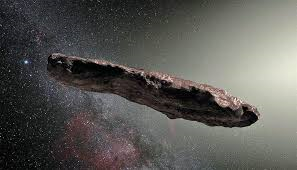
In the Dune series of science fiction novels there are these massive ships called Guild Heighliners. They are gigantic cigar-shaped vessels that move at greater than the speed of light because the Guild Navigators have learned how to “fold” space. The novels are Sci-fi masterpieces and go into wonderful detail. Last fall, in the real world, Hawaiian astronomers were shocked and a little bit frightened when the picked up a huge cigar-shaped object racing past the sun at nearly two hundred thousand miles an hour. They named the object ‘Oumuamua, which roughly translates from Hawaiian as “advance scout” or “first distant messenger”. The first character is a Hawaiian ʻokina, not an apostrophe, and is represented by a single quotation mark and pronounced as a glottal stop; the name was chosen by the Pan-STARRS team in consultation with Kaʻiu Kimura and Larry Kimura of the University of Hawaii at Hilo. Some astronomers genuinely believed the 400-meter-long object was an alien spacecraft, while others argued that that it was a comet.
“For me as an astronomer, the idea that we have now seen an object up close that not only came from another star system, but one that is very different from our own, was awe inspiring,” Dr. Alan Jackson, an astronomer at the University of Toronto Scarborough, and leader of scientists who conducted the research,” said at the time.
This artist’s illustration shows ‘Oumuamua racing toward the outskirts of our solar system, and is annotated with the locations of the planetary orbits. As the complex rotation of the object makes it difficult to determine the exact shape, there are many models of what it could look like.
For the study, published March 19 in Monthly Notices of the Royal Astronomical Society, Jackson and his collaborators performed 2,000 computer simulations of binary star systems with a small third body representing an object like Oumuamua. Previous research had shown that when small bodies get close to the center of the system their orbits become unstable, Jackson said. But it was unclear whether small bodies in binary systems wind up hitting one of the stars or being ejected from the system.
“We found that the overwhelming result is ejection with almost none of the small bodies hitting one of the stars,” Jackson said. Based in part on that finding, the scientists concluded that more than 95 percent of objects like Oumuamua originate in binary star systems — and that Oumuamua was one such object.
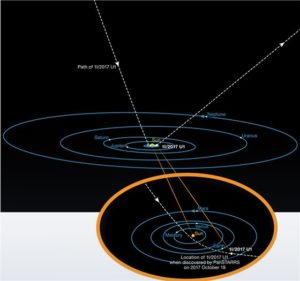 “Dr. Jackson’s statistical finding that such objects would most likely come from binary star systems, ejected through their gravitational interactions, makes sense,” Dr. Jay Pasachoff, an astronomer at Williams College in Williamstown, Massachusetts stated. “Of course, we already get particles known as cosmic rays and neutrinos from afar, along with light and its sister radiations plus gravitational waves, but it is exciting to have a macroscopic object.”
“Dr. Jackson’s statistical finding that such objects would most likely come from binary star systems, ejected through their gravitational interactions, makes sense,” Dr. Jay Pasachoff, an astronomer at Williams College in Williamstown, Massachusetts stated. “Of course, we already get particles known as cosmic rays and neutrinos from afar, along with light and its sister radiations plus gravitational waves, but it is exciting to have a macroscopic object.”
The path of the interstellar asteroid Oumuamua as it passes through the solar system. Unlike all other asteroids and comets observed before, this body is not bound by gravity to the sun. It has come from interstellar space and will return there after its brief encounter with our star system.
Jackson said astronomers were fairly confident that Oumuamua didn’t come from a nearby system but that it was hard to know its exact origins. As for its age, he said, “Oumuamua could well have been out there for hundreds of millions of years. Unfortunately, because it came through our solar system very fast and was only discovered when it was already on its way out, our observations of Oumuamua are quite limited.”
Eventually though, most scientists as the time thought that the reddish-tinged thing was an interstellar asteroid which would have made it the first known visitor to our solar system from another. A study suggests conducted at the time concluded that it was launched toward us from a star system with two suns.
Now before all you Sci-Fi buffs draw the obvious conclusion that it is a capsule containing a giant baby superman or a whole nursery of normal sized baby supermen, you can let out you collective breath. A recent study published this past week in the journal indicates that Oumuamua, is neither an asteroid nor an alien spacecraft, but a small interstellar comet. “It’s the only such object discovered so far,” Marco Micheli, an astronomer with the European Space Agency and the lead author of the new study, told NBC News MACH in an email.
Comets are usually larger icy, dusty objects which have sometimes been that have been compared to “dirty snowballs. When they pass close a star like the sun — the gases they release ignite and often form long tails that become very visible in the night sky. Oumuamua never displayed a tail which is one of the reasons that astronomers thought it must be an asteroid or a ship of some sort.
Now that it is much closer, new observations made by ground-based telescopes and the Hubble Space Telescope indicated that Oumuamua’s trajectory couldn’t be explained solely by the gravitational forces exerted on it by the sun and the planets — as would be the case if it were an asteroid, or space rock. “Unexpectedly, we found that Oumuamua was not slowing down as fast as it should have under gravitational forces alone,” Micheli said in a statement.
His team concluded that the unexpected motion of Oumuamua had to be caused by the spewing out of small quantities of gaseous materials from its surface. This “outgassing” — commonly seen in comets — was too small to be visible but significant enough to affect Oumuamua’s trajectory.
But not everyone is buying that explanation — at least not completely. Alan Jackson has said that if Oumuamua is a comet, it must be one that lost much of its ice before leaving its home star system. “A comet that has lost enough of its ice is essentially the same as an asteroid,” he said. “Oumuamua thus seems to be in that ambiguous region between the two.” Jackson conducted previous research on Oumuamua but was not involved in the new study.
Whatever its precise identity, Oumuamua might be just the first of many such interstellar visitors we’ll encounter. Jackson said new telescopes should help astronomers find “a lot more objects like Oumuamua and we will then be able to put together a more complete picture of what the building blocks of planets look like in other planetary systems, which will also help us to understand how planets form.”
Oumaumau is now headed to the outer solar system at a speed of about 70,000 miles per hour. Astronomers expect it to pass Neptune’s orbit in four years. “The object is now too faint to observe, so no new data will be acquired,” Micheli said. “But I expect scientists will keep working on their data for quite some time.”
Seen from Earth, the apparent trajectory makes annual retrograde loops in the sky, with its origin in Lyra, temporarily moving south of the ecliptic between 6 September and 16 October 2017, and moving northward again towards its destination in Pegasus.
“


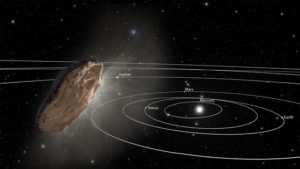
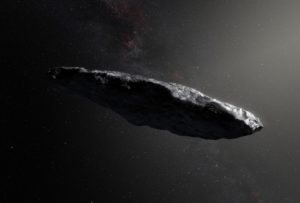
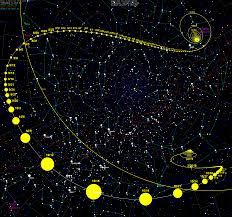
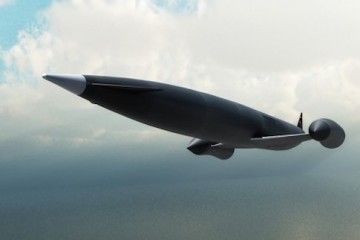

No Comment